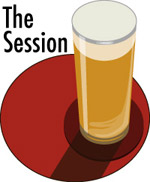 Oops. The Session #103: “The Hard Stuff” kind of snuck up on me.
Oops. The Session #103: “The Hard Stuff” kind of snuck up on me.
Natasha Godard at MetaCookBook’s marching orders include two parts:
– What do you want people in beer culture to be talking about that we’re not?
– What do you have to say on the topic(s)?
Reading Boak & Bailey’s contibution this morning first reminded me that I’d totally forgotten what day it was, and second led me to realize I jumped the gun last week when I asked, “Is gentrification good for more expensive beer?”
“More expensive beer” being code for “craft beer” and that is part of a larger question: Does that entity people call craft beer have a different role in society than beer has had for the last 200 years (or 50 years, or 400 years, you pick)? It is certainly related to the hypothetical book Maureen Ogle wrote she’d write (if she were writing one).
But, here’s the thing, that’s a big topic, one that requires research, and supporting statements with facts. Granted, I’m a bit obsessive, so coming up with the first question is relatively easy; committing to the “what do you have to say” before I’ve collected the facts is a non-starter.
Beer does not need to be a vehicle for “doing good,” but it gets extra credit when it does (as I started typing this sentence a tweet from James Schirmer buzzed on my phone, pointing to one such story). It’s easy to find stories when there are press releases and press conferences. It’s also more fun to write the feel good stories, the brewer who started out working as a server at the local brewpub who gets pour the first beer she wrote a recipe for.
But would be better if a hard question or two were asked, and answered. For instance, how many stories have you read about the role a brewpub (or several of them) played in upgrading a neighborhood? How many of them included anything about the people who used to live there? There’s a difference between improving a neighborhood and improving a community.
(I promise to feel guilty the rest of the day for not writing a post that actually tackles the hard stuff, but it’s a long way home and I have a plane to catch.)
 Host Mark Ciocco has announced the theme for The Session #105 will be Double Feature and there will be no shaking of the head and muttering, “How do I write about that?” He provides a record number of possible approaches.
Host Mark Ciocco has announced the theme for The Session #105 will be Double Feature and there will be no shaking of the head and muttering, “How do I write about that?” He provides a record number of possible approaches.